This mirror is being hosted with the permissions of the original content creator for preservation and educational purposes.
While most problems that occur with corals stem
from water quality and
lighting issues, there are the occasional problems with disease and
parasites of corals. Just as with everything else we keep in our
systems, water quality plays a major role in the health of our corals,
being put under any type of stress makes any animal more susceptible to
other problems, such as disease. As such, any attempt at a cure or a
solution should take water quality into account first and corrected if
need be.
I have never personally had to deal with many coral
diseases or
parasites, yet. But since it is my goal to provide or at least gather
as much information as possible about any and all topics within our
hobby, I have gathered the following links to what I feel are the best
informational sites on the web concerning diseases and parasites of
corals. I hope I have at least, saved you some searching time.
Noted
Coral Problems / Reactions
Coral Bleaching -
" What
is bleaching? Bleaching occurs in corals that maintain a symbiosis with
various types of dinoflagellates called zooxanthellae. By one common
definition, bleaching is the release, rejection, or loss of
zooxanthellae from coral tissue.
Bleaching
and Disease "Look Alikes" - "In
this article, I limit myself to those corals having white areas that
are not caused by bleaching or disease"
Starvation - "We investigated the effect of
zooplankton feeding on tissue and skeletal growth of the
scleractinian coral Stylophora
pistillata.
Micro colonies
were divided
into two groups "
Tissue Recession -
Not a very specific term other than to describe an effect of
any
number of causes, which could be anything from poor water quality, such
as high phosphate levels, poor water flow, too much or not enough
light, starvation, abrasion wounds, puncture wounds and of course any
number of diseases and parasites. I suspect the majority of causes stem
from an improper environment and would be on the top of my list of
things to check.
Note:
This effect can be very confusing because while it may be an
actual pathogen at work, the appearance of a bacterial line forming on
the edge of the tissue loss may only be the result of bacteria
consuming the dead tissue matter just as it would any other dead
animal. In short, a bacterial clean up crew could easily be mistaken
for the cause of the coral's tissue loss while ignoring other
possibilities such as poor water quality, nutrition, lack of water flow
and so on.
Coral Allelopathy : It is
extremely common to see any number of aquariums keeping a wide
assortment of corals species all within the same aquarium. This is
extremely stressfull to the "sps" corals when they are subjected to the
toxins released by other corals, such as many of the "soft" corals, the
Coralliamorphs (mushrooms) and Gorgonians. All of which, when enclosed
in such relatively small amounts of water makes for a very toxic soup.
Even other stony coral species can be the cause as well. Species such
as Galaxea, Hydnophoras and even Anemones all release either free
floating
stinging cells or other irritants as they shed mucus.
Coral
Neoplasia
: A neoplasm is an abnormal mass of tissue that grows through the
proliferation of undifferentiated coral cells. These cells grow and
multiply more rapidly than normal and lack the structural organization
and function of the normal tissue which gives the calcified formation
the appearance of being another organism growing on the coral.
The exact cause of this condition is unknown but is thought to be a
genetic mutation that may be the result of environmental conditions.
Please see the above link for more information.


Coral Neoplasm :
Photos by LarryK
Coral Hyperplasia
: Some corals can have circular areas in which the
pattern
of the corallites are distinctly different, usually
enlarged
and protruding above the surface of the colony and altering the pattern
of the corallites adjacent to it so that it appears to be
compressing the growing tissues. Microscopic examination of tissues
from such an area revealed an increase in the number and size of cells
and proliferation of all types of tissues. This type of growth has been
termed a hyperplasm. It appears that such growths originate from a
single budded polyp that undergoes localized, rapid growth, while
retaining functional fusion of its tissues with those covering the
normal colony skeleton. As with Neoplasia, the cause of this
skeletal or growth anomaly is unknown but is also thought to be a
genetic mutation brought on by environmental factors.
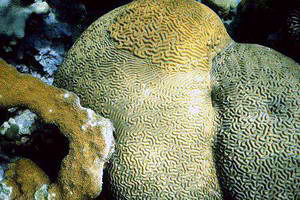
Coral Hyperplasm : Photo by
E.C. Peters
Coral Starvation : Yes,
it is very possible to starve a coral, even those that are considered
to rely heavily upon light for their needs. When tanks are low
in
nutrients, the corals have lower amounts of zooxanthellae and their
pigment content declines. If there is not enough Nitrogen to produce
protectant pigments like MAAs and probably other things like SOD and
other enzymes and proteins, then the effects of UV and strong lighting
become too much, causing the demise of the coral.
Tissue / polyp expansion :
At times what
we perceive as the coral doing well, the expansion of polyps such as a
goniopora for example, may also be an indication that it is attempting
to gather more light in a poorly lighted aquarium. In the LPS
coral species, besides an attempt to gather more light, it may also be
an attempt to flush itself of poor water conditions or a feeding
attempt to gather nutrients from excessively nutrient poor water. If
this condition occurs after you have made a change to the system, such
as increased carbon use, or a binding agent, that could be the most
likely candidate for
the cause of the problem.
Coral Tissue Bubbles :
At times, a coral may exhibit what appears to be bubble shaped voids
under the corals
tissue, its usually a damage induced reproductive strategy that (may)
lead to a polyp bailout. It can simply be caused by stress (as with
light shock from a change of lamps, increase in light, sudden use of
carbon or water changes that drastically clarifies water, etc)... or it
can be stimulated by a burn from another attacking coral.
CORAL
DISEASE IDENTIFICATION
 Is this Rapid Tissue Necrosis or a
Parasite at work?
Of course having to figure out what you are actually looking
at
needs to be accomplished before a treatment plan can be decided upon.
Since most parasites / predators are nocturnal, it may take a few
nights of diligent watching to determine if there is a predator or not
at play. I must stress that environmental factors should be ruled out
first.
Is this Rapid Tissue Necrosis or a
Parasite at work?
Of course having to figure out what you are actually looking
at
needs to be accomplished before a treatment plan can be decided upon.
Since most parasites / predators are nocturnal, it may take a few
nights of diligent watching to determine if there is a predator or not
at play. I must stress that environmental factors should be ruled out
first.
I have seen a great many online questions
regarding the loss
of Acropora species as well as having other corals slowly becoming
unhealthy and eventualy dieing. A great many times, this can be
attributed to an improperly stocked aquarium. In that, we all would
like to see a nice mixture of coral species within our systems. Yet
this same mixture will most always lead to trouble in being able to
maintain the more sensative species such as the acroporas. Of course,
elevated levels of nutrients and the overall quality of the water can
play a large role as well. But if you are trying to keep coralliamorphs
(mushrooms), gorgonians, large polyped corals and others, such as
hydnophora, galaxea or any of the "soft" corals. You are in effect
creating a toxic soup within your aquarium through the release of such
coral's chemicaly defesensive methods (aleopathy). So if you see your
Acropora species losing tissue fairly quickly, you might want to take a
hard look at what species you are keeping together. If you wish to keep
species such as the Acroporas and Montiporas, I suggest you keep only
those species in your aquarium.
Coral Pathogens Identified for White Syndrome
- " White Syndrome (WS), a general term for scleractinian
coral diseases with acute signs of advancing tissue lesions often
resulting in total colony mortality."
Uncharacterized Diseases
- "
Many coral diseases have
not been characterized under peer-reviewed venues. At the present time
much confusion and disagreement exists about these diseases
"
Field Guide to Coral Diseases
- " This section of the guide
presents some of the common coral diseases. For each disease an
illustrated description of the disease characteristics is given as well
as an illustrated list of species the disease is known to afflict.
Information on Coral Diseases
- " This cross section of
disciplines was an intentional effort to enlist techniques and ideas
from various fields to help accelerate the slow progression of advances
in the study of coral disease. "
Major Reef-building Coral Diseases
- " Coral diseases and
syndromes generally occur in response to biotic stresses such as
bacteria, fungi and viruses, and/or abiotic stresses such as increased
sea water temperatures, ultraviolet radiation, sedimentation and
pollutants. One type of stress may exacerbate the other (Santavy and
Peters, 1997). "
CORAL
DISEASE TREATMENTS
Bacterial Diseases -
" Most
of the bacteria in the ocean are one kind of Vibrio or another. Many of
them are good citizens. Some of them are luminescent, and help deep
water fish and squid be bioluminescent. This is a symbiotic
relationship between the larger host organism and the bacteria.
Moreover, the symbiosis is often intracellular. So Vibrio can get
inside cells of higher organisms. "
Rapid Tissue Necrosis (RTN) - "
RTN
has been described in the wild as 'Shut-down reaction' by Antonius as
early as the late-70's. So far, I have not seen a paper that describes
this as a proper 'disease', per se. (i.e. fulfills Koch's postulates...)
"
Note: From a lot of reading, I have noticed that
the only effective
treatment of just about any coral disease involves the use of an Iodine
dip, there are a few commercially prepared mixes that you can buy. I
would recommend the use of a prepared mix over trying to make one
yourself. So far, the most popular brand seems to be "Lugols". Keep in
mind that all such treatments have to be done outside of the main tank.
Do not ever try to treat the entire tank. Also, do not use a freshwater
dip on corals, this alone will probably kill the coral.
Home made Lugols Dip - The
most common recipe is 10g
potassium iodide dissolved in 100ml distilled water, add 5g iodine
crystals till dissolved. Be careful with iodine crystals, they
are
rather caustic and need to be handled with care. Store it in a dark or
amber glass bottle away from light. No need to refrigerate.
CORAL
PARASITES / PREDATORS
A Tip :
Since most
parasites / predators tend to be extremely small, I have found that by
using my digital camera as a magnifying lens helps to look over a
specimen using the camera's zoom capabilities while watching
the
camera's monitor screen, if a suspect animal is found, a photo can be
taken of it since you already have the camera in focus and aimed at the
suspect, which the photo can then be used for further study and also to
submit to experts in this field for identification purposes.
SNAILS
With the wide variety of snail species
coming into our aquariums as hitch hikers, we stand a fairly
good chance of getting some coral predators as well. Most of
these will be small and difficult to detect and are usually only
detected when we notice visible damage to a coral . Since such
predators are usually always nocturnal, they are best looked for after
the lights have been off for a few hours. This same nocturnal feeding
behavior is also typical of most other coral predators / parasites.
This is where I have to stress the importance of a quarantine
routine, a coral, once in the landscape, makes detection of such
problems very difficult to do.
Feeding
Method : Snails such as the drupella genus have
specialized mouth parts that are used to rasp away the living tissue of
the coral.
Treatment
/ Removal Method :
When discovered the visible adults / juveniles can be picked
off
of the coral and disposed of. It is also recommended that the effected
coral be dipped in a lugols (Iodine) solution to kill any possible egg
masses left by the adults.
The below photos are of the species that
I have personally found
to be feeding on my acropora corals, and were removed right away while
having no eggs masses discovered. I am not sure if the lack of egg
masses was due to the snails being unable to breed in my system, or if
I had just caught them before they had a chance to do so.
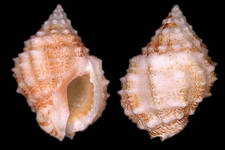
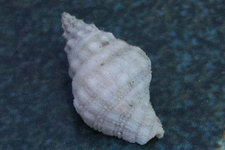

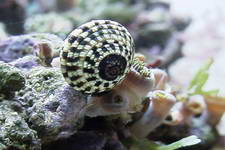
Drupella
cornis
Coralliophila Sp
Unknown species
Heliacus - Zooanthid predator

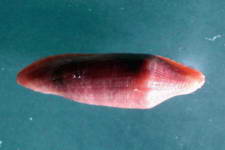

Calpurnus
verrucosus
Primovula sp.
Calpurnus lacteus
Predator of leather corals
Predator of
Gorgonians
Predator of soft corals
COPEPODS / AMPHIPODS
These are
probably the most insidious and difficult of the coral parasites to
detect and remove owing to their small size and breeding potentials, as
well as some species embedding themselves into the coral's tissue as
well.
Treatment(s)
: Red Bugs ( harpacticoid copepods )
Note: Any and
all treatments should be performed outside of the main tank.

Acropora "red bugs"
There
are numerous nudibranch and
flatworm species
that specialize in feeding on specific coral species. Most, but not all
of which can only predate a specific coral species, which in itself is
a good thing since as a last resort, we can simply remove the
effected
coral and isolate it for treatment without concern that other coral
species may be in danger.
Treatments:
Note:
All
treatments should be performed outside of the main aquarium in a
quarantine setting.
- Two Potential Molluscicides Against Pest
Aeolid Nudibranch - "
A molluscicide is a compound that
kills molluscs, of which nudibranchs are an unshelled type. Most of the
agents I found that are used in terrestrial studies and practice would
be toxic to either the aquarium or the coral."
-
Metronidazole™
— Is
a highly pure, crystalline metronidazole. Use 1 to 2 measures (each
about 100 mg) for every 40 L (10 gallons). Repeat every 2 days as
required.
-
Iodine
-
(ex. lugols iodine, Tropic Marin pro-coral cure, Seachem
reef dip) when used at recommended dosages and times, these medications
will kill most if not all adults. Throughout the procedure it
is important to stir the coral in an effort to detach any adults from
the coral. Once the dip is complete, the coral
should be inspected for any nudibranch remnants which can be removed
using a toothpick.
-
Fragmenting
- As a last ditch
effort, you can also fragment off healthy, nudibranch free sections of
the coral and throw away the effected coral areas.
-
Manual
Removal - Since most
nudibranch are very prey specific, you can also remove the effected
coral species from the main aquarium and place into a quarantine tank.
Once removed, the coral can then be closely inspected for adult
nudibranch and egg masses which can be manualy picked off and removed.
The only downside to this method is that it can take a good many months
for the nudibranchs that were left behind in the main aquarium to die
off from starvation.
-
Levamisole
- A drug created to treat worm
infestations in animals. It acts as a contact poison
blocking nerve transmission to kill or stun the parasite. This
drug has proven to be a very effective treatment for both parasitic
nudibranchs and flatworms. A recommended minimum
dosage of
50ppm for a total duration of 10 hours or more is advised. At this
dosage the nudibranchs become paralyzed and fall off the
coral. Note, Levamisole is only available with a prescription
from
a licensed Veterinarian.
- Natural predators - Fish
such as certain members of the Pseudocheilinus (Sixline wrasses), Coris
(Coris wrasses), and certain Thalassoma (Banana wrasses)
Genus’ are known to actively feed on these
nudibranchs. While this can be an effective control
mechanism, it may not completely get rid of all nudibranchs.
Most of these wrasses lack the mobility to get to most of the places
where the nudibranchs hide. There are many other natural
predators, including certain crabs, several other nudibranchs, and
perhaps more, however these are not as commonly available to the
aquarist as the aforementioned fish.
NOTE:
Freshwater
dipping is a very dangerous yet very effective treatment option.
Freshwater creates a large difference in osmotic pressure between the
inside and outside of the body of the nudibranchs. This sudden change
in osmotic pressure causes the cells to rupture and quickly kills the
nudibranch. The dip must be done with de-chlorinated water adjusted to
the pH and temperature of the tank and must last no longer than 15
seconds. Note, this is not recommended as a safe treatment option as it
can be very harmful to the zooxanthellae in the coral, longer exposure
times can and will kill coral. I would not recommend this method unless
all else has failed.
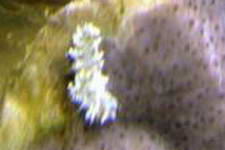
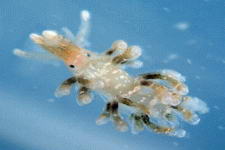
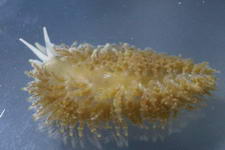
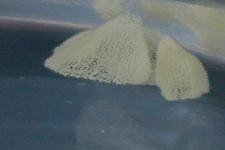
Nudibranch
consuming a Montipora Acropora predator (Aeolid nudibranch)
Porites Predator
and its egg mass
SPONGE /
ALGAE
These potential problems not only can be a direct cause of
coral damage but as most of us have found out already, can
also
be a secondary problem in that any damaged coral skeleton can easily be
used as a surface area for the growth of many other life forms to take
up residence on. Once established, the coral will find it all but
impossible to regain any lost ground simply because the sponge and/or
algae are so much faster in their growth that the coral just can not
compete, and may find itself losing even more ground.
Treatment
: In the case
of sponge, it may just be a case of having to cut out / off the
effected area of the coral. For algae, keeping the surface cleaned of
it by either manual removal or placing a herbivore snail onto the area
on a regular basis to do the cleaning. For cyanobacteria,
increasing the water flow over the corals will usually prevent this
problem, assuming of course that phosphate levels are also controlled.
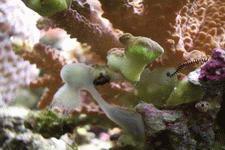
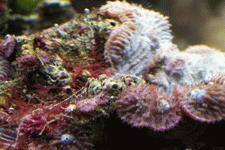
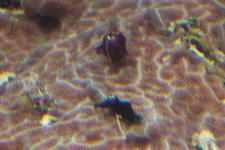
Encrusting
sponge
Algae competition
Surface
CyanoBacteria
STARFISH & URCHINS
These two animal groups are a good reason to always do your
best to identify any and all
hitch hikers
into your system. While interesting and beautiful, many of these
animals are in fact very predatory. A few examples are shown below.
Treatment : Only physical removal as they are found
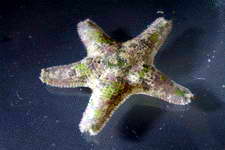
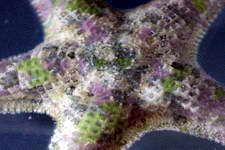
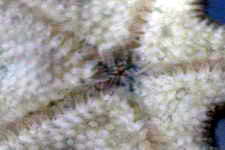
Unidentified Coral Predator - Found
consuming an entire Lithophyllon coral colony within my system.
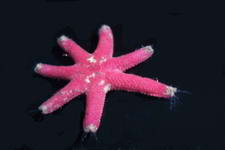

Echinaster luzonicus
Cidarid Urchin
WORMS
While I have only seen or found a few species of
worms
that could be considered a threat to corals, they are none
the
less a few species that can become a problem for corals. I do want to
stress that the vast majority of worms found as hitch hikers are
valuable members of a clean up crew and it is very important to
properly identify the species of worm before you condemn it. Shown
below are examples of worm genus groups that do have members that could
pose a risk. For identification of worm species, please see the
relevant section of my hitch hiker pages.
Treatment
: Actively trapping them or introducing a biological
control to the aquarium such as some wrasse species.
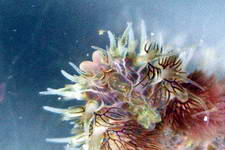
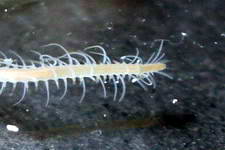
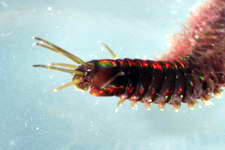 The
Amphinomidae
The
Syllidae
The Eunicids
The
Amphinomidae
The
Syllidae
The Eunicids
Burrowing Worms : While
unable to obtain the actual organism that created the below problem, it
is apparent due to the formation of calcified tubes that a worm species
is most likely the cause. As this pest species first infests
a coral colony, it first builds its own structure on top of the
corallite's walls, which block light and water flow to the underlying
polyp. The polyp then slowly dies over the course of weeks
and months allowing these and other organisms to further colonize the
coral skeleton substrate, effectively killing the coral colony little
by little.
Formation of dead
and soon to be dead areas on the coral colony. Even in
seemingly healthy areas of the colony, these organisms are already
present as individual formations on top of the corallites. In
the most affected areas, the organism has burrowed through the walls of
the corallites.
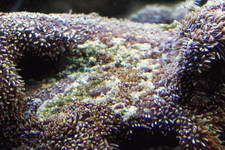
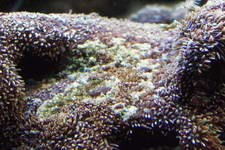


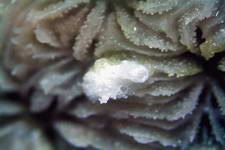
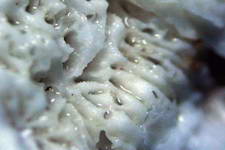
Below,
what appears to be a burrowing worm that leaves behind its drilled
coral skeletal fragments in a ball of mucus, below the mucus ball the
coral's tissue is dead.
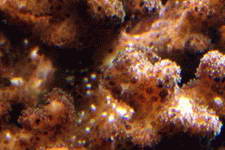


CRUSTACEANS
While normally not direct predators of corals, they can
cause
enough damage as to cause the coral's death . Many of the xanthid
species of crabs burrow into coral skeletons as shelter and as they
themselves grow, they enlarge the cavity, much to the detriment of the
coral. Other species, such as some of the arrow crabs will readily
learn that they can rip open a coral polyp and remove the gut contents
of the coral polyp. There are of course very small species of crabs
that do act as a true parasite of corals.
Treatment
: Physical removal


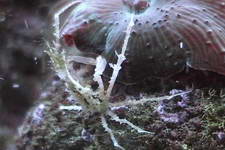
Xanthid Crab
Xanthid Crab
Arrow Crab
All of the above
demonstrates another very good reason to use a strict
quarantine procedure for everything that you will place into your
aquarium. As small as most parasites are, they will be much easier to
detect in a small quarantine than once placed in the main tank. It will
also help to prevent the spread of such problems.
INVASIVE PESTS
It is quite common to find any number of sessile worms, crustaceons or
snails that have bored through a corals tissue to get at a substrate to
attach onto. Such animals while normaly small in comparasin to the
coral and pose no real danger to the coral, they can however start to
become a problem in enclosed systems such as our aquariums. If such an
animal reproduces well within our systems, their numbers can become so
great as to start causing the coral health issues, thankfully this is
an extremely rare event.


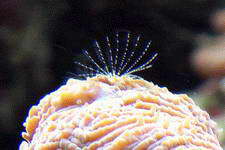
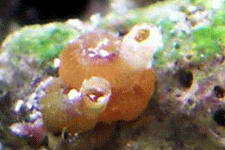
Spionid Worm
Flabelligerid Worm
Barnacle
Vermetid Snail
There
are however, some
sessile inverts that are relatively large and if they do invade a
single coral polyp, they can cause the death or slow decline of that
individual polyp. It would be these that I would take the effort to
remove. To do so, remove the coral from the water, very slowly to give
the polyp(s) time to retract. Then with a needle nose plier, or a pair
of tweezer, pinch or break off the offending animal as close to the
coral's tissue as possible without disturbing or damaging the corals
tissue. Any remains of the offending animal, such as a calcified tube
will be overgrown by the coral in due time.
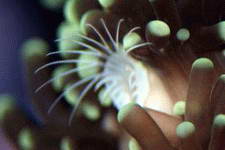
A large invasive barnacle.
ADDITIONAL ARTICLES / INFORMATION
Predators and Parasites of Corals -
There
are many species of predators that specialize in eating coral, the most
common are nudibranch, snails and copepods. Each predator or parasite
will usually have one specific species of coral that they can eat.
While
any of these predators may destroy a single specimen within our
aquariums, the bright side is that the other species of corals within
the aquarium are safe. The removal and treatment of the
effected
coral will usually stop the predator in its tracks. Most notably
nudibranch and "red bugs".
OF OTHER INTEREST
Coralline Lethal Disease
- " A
second disease of coralline algae was recognized by Tom Goreau in the
Caribbean in 1996. It lacks the characteristic orange color of CLOD,
but is lethal, nonetheless. "
Coralline Lethal Orange Disease
- "
Given
the importance of coralline algae in contributing material to the reef
framework, it was particularly disturbing when a disease of coralline
algae was discovered "
All Photos and Content are
CopyRight Protected
and may not be used or
reproduced elsewhere
without permission of the
authors
Please take a moment and
consider supporting any one of the projects listed within. Thank you.
This mirror is being hosted with the permissions of the original content creator for preservation and educational purposes.




 Is this Rapid Tissue Necrosis or a
Parasite at work?
Of course having to figure out what you are actually looking
at
needs to be accomplished before a treatment plan can be decided upon.
Since most parasites / predators are nocturnal, it may take a few
nights of diligent watching to determine if there is a predator or not
at play. I must stress that environmental factors should be ruled out
first.
Is this Rapid Tissue Necrosis or a
Parasite at work?
Of course having to figure out what you are actually looking
at
needs to be accomplished before a treatment plan can be decided upon.
Since most parasites / predators are nocturnal, it may take a few
nights of diligent watching to determine if there is a predator or not
at play. I must stress that environmental factors should be ruled out
first.






































